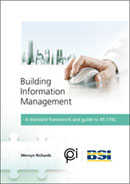Construction Project Information (CPI) and RIBA Enterprises ran a couple of workshops on the forthcoming changes to Uniclass, in Manchester and London on January 31 and February 3 respectively. The events – part of an industry consultation process – had three speakers:
- Sarah Delany, CPI Secretary and NBS Technical author, RIBA Enterprises
- John Gelder, Head of content development and sustainability, RIBA Enterprises
- Dr Stuart Chalmers, Technical research officer, RIBA.
CPI initiatives

Sarah presented a number of CPI initiatives, including the following:
- BIP 2207
 : Building information management: A standard framework and guide to BS 1192
: Building information management: A standard framework and guide to BS 1192 - A revised Uniclass table for elements, combining Uniclass tables G (building elements) and H (civil engineering elements), currently being used by Crossrail. This is incorporated in the next two items
- CPIx Layer generator
 – tables G and Z only, to date. This is for use of these tables in CAD
– tables G and Z only, to date. This is for use of these tables in CAD - CPIx Uniclass code request tool
 – tables G and Z only, to date. This is for users who need an official classification, which other users can share, for an object not currently classified. Uniclass is to be a dynamic rather than a static classification system
– tables G and Z only, to date. This is for users who need an official classification, which other users can share, for an object not currently classified. Uniclass is to be a dynamic rather than a static classification system - CPIx Protocol
 , to replace the current PIX Protocol on project information exchange
, to replace the current PIX Protocol on project information exchange - Construction Industry Confederation (CIC) project, on 'data drops' and project phases.
More information on each of these can or will be found online at www.cpic.org.uk ![]() .
.
Unifying Uniclass

A major CPI initiative is the development of a 'unified Uniclass', Uniclass 2, to replace the current version of Uniclass ![]() . CPI has commissioned RIBA Enterprises to develop the first tranche of draft unified tables for Easter 2012, for comment. The Work sections table is already online
. CPI has commissioned RIBA Enterprises to develop the first tranche of draft unified tables for Easter 2012, for comment. The Work sections table is already online ![]() . Others tables will be following shortly, e.g. for Systems, Products and Elements.
. Others tables will be following shortly, e.g. for Systems, Products and Elements.
John is engaged in this work, and presented on the following:
- The current context of construction classification, including the use of defunct systems such as CI/SfB 1976
 , and alternative systems such as SFCA 2008
, and alternative systems such as SFCA 2008  and NRM 2012
and NRM 2012  , both for elements
, both for elements - The review of the Uniclass parent standard, ISO 12006-2:2001
 , for which John is the 'UK expert'. This included a look at a proposal that the standard include for classification by composition
, for which John is the 'UK expert'. This included a look at a proposal that the standard include for classification by composition - Some problems with Uniclass 1997, and the solutions proposed for Uniclass 2, particularly congruence between tables – the use of common sequences, codes, and terminology, to facilitate mapping. All tables will cover buildings and landscape, and civil and process engineering
- Some problems with current Uniclass table J (also known as the Common Arrangement of Work Sections – CAWS
 ), for Work sections, and the solutions proposed. NBS Create is the first industry implementation of this new Work sections table, which can now serve the whole project timeline
), for Work sections, and the solutions proposed. NBS Create is the first industry implementation of this new Work sections table, which can now serve the whole project timeline - The standard, but versatile, system section structure assumed in the new Work sections table, also implemented in NBS Create.
For those seeking more information on this 'unifying Uniclass' work, there are some key articles online at thenbs.com – 'Revising ISO 12006-2', 'Unifying Uniclass', and 'The new Uniclass Work sections table'.
A point to bear in mind is that, while we are working from the bottom up at the moment (from NBS Create to Uniclass 2 to a revised ISO 12006-2), once the new ISO and the new Uniclass are in place, classification will also work from the top down. Uniclass 2 should conform to the ISO, and NBS Create (and all other UK implementations) should conform to Uniclass 2 as it evolves courtesy of the Uniclass code request tool, mentioned above.
Semantic web
Mapping between current and future classification systems, in the UK and beyond, and within changing systems, is something that will be facilitated through a TSB-funded project being carried out by the RIBA and the University of the Arts London.
Stuart presented his work on this Semantic Web project, looking at the need for:
- Integrated, interoperable data in the world of BIM, e.g. using XML and other standard data formats
- Use of linked, open data standards, through the Semantic Web
 – "the web done right" – using unique online web identifiers (URIs), structured machine readable information describing your data, and links to other relevant reusable data sources
– "the web done right" – using unique online web identifiers (URIs), structured machine readable information describing your data, and links to other relevant reusable data sources - Tools for integrating and using Uniclass in BIM systems
- A systematic and structured versioning and revision process for updating Uniclass.
Information on the RIBA/UAL project will be found online at www.bimgateway.co.uk ![]() from the end of February.
from the end of February.
The workshops were well received, with a number of questions from the floor, particularly in London, and several quite lengthy questions by subsequent emails. We encourage interested readers to have a critical look at the draft Uniclass 2 tables and pass their constructive comments on to CPI. Common queries and comments, and our responses, will be developed as FAQs and delivered online.

